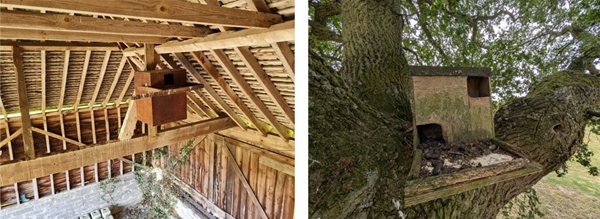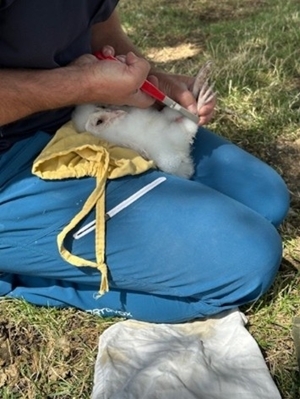By Sophie Jackson, Wildlife Recovery Placement Student
 Few sights are as magical as a barn owl gliding over a field on a summer’s evening. With their heart-shaped faces, ghostly plumage and soundless flight, they have long been described as ethereal and mysterious. I’ve always found barn owls captivating, but being part of this project has taken that fascination to another level. Watching them up close has given me a deeper appreciation for just how remarkable they are. What started as an interest in helping with practical conservation has grown into a real admiration for these birds, not just for their beauty and mystery, but for their resilience and the role they play in our countryside.
Few sights are as magical as a barn owl gliding over a field on a summer’s evening. With their heart-shaped faces, ghostly plumage and soundless flight, they have long been described as ethereal and mysterious. I’ve always found barn owls captivating, but being part of this project has taken that fascination to another level. Watching them up close has given me a deeper appreciation for just how remarkable they are. What started as an interest in helping with practical conservation has grown into a real admiration for these birds, not just for their beauty and mystery, but for their resilience and the role they play in our countryside.
Despite being one of the UK’s most loved birds, their story has not always been a straightforward one. The barn owl experienced a dramatic decline throughout the 20th century due to various factors, including:
- Reduction in prey habitat through agricultural intensification and urban expansion.
- Fewer nesting sites as traditional barns were converted, and Dutch elm disease removed old trees.
- Harsh, wet and cold winters with excessive snow cover.
- Secondary poisoning from rodenticide and pesticide use.
- Increasing road traffic collisions.
Despite these challenges, their populations have made a remarkable recovery since the 1990s. Nevertheless, barn owls continue to depend on the goodwill and support of us humans. One important way of supporting these birds has been through the installation of nest boxes, providing them with suitable and safe roosting and nesting sites. Protecting and monitoring these birds therefore relies heavily on the support of farmers, landowners, and dedicated volunteers.
Installing homes for owls
Our team consisted of myself, Dr Francis Buner (Head of Wildlife Recovery at the GWCT) and Dr Matt Stevens from the Hawk Conservancy. During the winter, prior to the breeding season, we installed specially designed boxes across the Selborne Landscape Partnership farmer cluster and surrounding area. These boxes were placed in barns and on trees at about 10-12 feet high (as high as a three-element ladder allows). Our aim was to install nestboxes at approximately two per km²: one for nesting and the other to provide a roosting location for adults as chicks approach the fledging stage.

Barn owl boxes set up in a barn and in a tree (Credit: Francis Buner)
During the breeding season, we carefully visited the boxes to check for activity. When owls were present, we worked with trained professionals to ring them. If a previously ringed bird was re-captured, its details were added to the British Trust for Ornithology’s (BTO) online database, known as DemOn (short for Demography Online). Ringing is an important conservation tool: by giving each bird a unique identification ring, scientists can measure their survival, movements, and long-term contribution to the population. All visits were carried out with the utmost care to ensure minimal disturbance to the owls.


Trained professionals carefully ring each bird (or record existing rings), determine sex and age, weigh them, and measure wing length
(Credit: Francis Buner)
We also recorded box use in a database, allowing us to map and analyse each box’s effectiveness. Sometimes, if a box was not being used, we would move it to a better position. This ongoing monitoring helps us make the project as effective as possible year after year. I have also written a fact sheet that outlines the best practice for monitoring barn owl recovery across farmer clusters, which is expected to be released this autumn.
Why barn owls matter
Barn owls are not only striking and beautiful, but they also play vital ecological roles. By hunting small rodents such as voles and mice, they provide a natural form of pest control, supporting both farmers and the wider ecosystem. Barn owls are also good indicators of ecosystem health; a healthy owl population suggests that the landscape is supporting abundant prey and suitable habitats. Culturally, barn owls hold a special place in folklore and symbolism, often associated with wisdom and mystery.
 Credit: Oly Berriman
Credit: Oly Berriman
Providing nest boxes is a simple but effective way to help and sustain barn owl populations. Research shows that barn owls readily adopt artificial boxes, and these safe nesting spots boost breeding success. Combined with habitat protection, nest boxes are helping to secure a future for this much-loved species.
How you can help
There are several ways in which landowners and local communities can support barn owls:
- Provide safe nesting places – Allowing nest boxes to be installed on farmland or rural properties is one of the most direct ways to help. Nest boxes should always be installed and monitored by trained professionals.
- Support local conservation groups – Many charities and volunteer organisations are dedicated to barn owl monitoring and conservation; and your support helps them continue this work.
- Protect habitats – Maintaining field margins, hedgerows and rough grassland provides the hunting grounds barn owls need to survive.
Looking ahead
Barn owls remain one of the most captivating sights in our countryside, but their future, as with many other species, depends on the choices we make today. The success of nest box programmes and habitat management has already shown that simple, well-directed conservation efforts can make a real difference. By continuing these efforts – with the support of farmers, landowners, conservation groups, and local communities – we can ensure barn owls have the resources they need to thrive and remain a familiar and thriving part of our landscapes for generations to come.
From a personal perspective, being part of this project has shaped how I think about agricultural conservation. I’ve seen first-hand how farmers and conservationists can work together in practical ways — like giving owls safe homes. It’s also shown me that if we put in the groundwork, nature has a remarkable ability to recover.
I’ll never look at a barn owl the same way again. They’re still every bit as mysterious and magical, but now they also remind me of databases, ladders, and a lot of teamwork. Conservation isn’t just about the big picture — it’s also about the stories and small victories along the way, and I’m glad I got to be part of this one.